Photophysical Behaviors of Single Fluorophores Localized on Zinc Oxide Nanostructures
Abstract
:1. Introduction
2. Results and Discussion
3. Experimental Section
3.1. ZnO Film Preparation
3.2. Bulk Fluorescence Measurements
3.3. Single-Molecule Fluorescence Spectroscopy and Imaging
4. Conclusion
Acknowledgments
References
- Chou, T.P.; Zhang, Q.F.; Cao, G.Z. Effects of dye loading conditions on the energy conversion efficiency of ZnO and TiO2 dye-sensitized solar cells. J. Phys. Chem. C 2007, 111, 18804–18811. [Google Scholar]
- Guerin, V.M.; Magne, C.; Pauporte, T.; Le Bahers, T.; Rathousky, J. Electrodeposited Nanoporous versus Nanoparticulate ZnO Films of Similar Roughness for Dye-Sensitized Solar Cell Applications. ACS Appl. Mater. Interfaces 2010, 2, 3677–3685. [Google Scholar]
- Keis, K.; Bauer, C.; Boschloo, G.; Hagfeldt, A.; Westermark, K.; Rensmo, H.; Siegbahn, H. Nanostructured ZnO electrodes for dye-sensitized solar cell applications. J. Photochem. Photobiol. A Chem 2002, 148, 57–64. [Google Scholar]
- Wei, D. Dye Sensitized Solar Cells. Int. J. Mol. Sci 2010, 11, 1103–1113. [Google Scholar]
- Biju, V.; Micic, M.; Hu, D.H.; Lu, H.P. Intermittent single-molecule interfacial electron transfer dynamics. J. Am. Chem. Soc 2004, 126, 9374–9381. [Google Scholar]
- Jin, S.Y.; Snoeberger, R.C.; Issac, A.; Stockwell, D.; Batista, V.S.; Lian, T.Q. Single-molecule interfacial electron transfer in Donor-Bridge-Nanoparticle acceptor complexes. J. Phys. Chem. B 2010, 114, 14309–14319. [Google Scholar]
- Wang, Y.M.; Wang, X.F.; Ghosh, S.K.; Lu, H.P. Probing Single-Molecule interfacial electron transfer dynamics of porphyrin on TiO2 nanoparticles. J. Am. Chem. Soc 2009, 131, 1479–1487. [Google Scholar]
- Grasset, F.; Labhsetwar, N.; Li, D.; Park, D.C.; Saito, N.; Haneda, H.; Cador, O.; Roisnel, T.; Mornet, S.; Duguet, E.; et al. Synthesis and magnetic characterization of zinc ferrite nanoparticles with different environments: Powder, colloidal solution, and zinc ferrite-silica core-shell nanoparticles. Langmuir 2002, 18, 8209–8216. [Google Scholar]
- Huang, M.H.; Mao, S.; Feick, H.; Yan, H.Q.; Wu, Y.Y.; Kind, H.; Weber, E.; Russo, R.; Yang, P.D. Room-temperature ultraviolet nanowire nanolasers. Science 2001, 292, 1897–1899. [Google Scholar]
- Johnson, J.C.; Yan, H.Q.; Schaller, R.D.; Petersen, P.B.; Yang, P.D.; Saykally, R.J. Near-field imaging of nonlinear optical mixing in single zinc oxide nanowires. Nano Letters 2002, 2, 279–283. [Google Scholar]
- Saito, N.; Haneda, H.; Sekiguchi, T.; Ohashi, N.; Sakaguchi, I.; Koumoto, K. Low-temperature fabrication of light-emitting zinc oxide micropatterns using self-assembled monolayers. Adv. Mater 2002, 14, 418–421. [Google Scholar]
- Yang, P.D.; Yan, H.Q.; Mao, S.; Russo, R.; Johnson, J.; Saykally, R.; Morris, N.; Pham, J.; He, R.R.; Choi, H.J. Controlled growth of ZnO nanowires and their optical properties. Adv. Funct. Mater 2002, 12, 323–331. [Google Scholar]
- Chatterjee, A.P.; Mitra, P.; Mukhopadhyay, A.K. Chemically deposited zinc oxide thin film gas sensor. J. Mater. Sci 1999, 34, 4225–4231. [Google Scholar]
- Fan, Z.Y.; Lu, J.G. Zinc oxide nanostructures: Synthesis and properties. J. Nanosci. Nanotechnol 2005, 5, 1561–1573. [Google Scholar]
- Kar, S.; Pal, B.N.; Chaudhuri, S.; Chakravorty, D. One-dimensional ZnO nanostructure arrays: Synthesis and characterization. J. Phys. Chem. B 2006, 110, 4605–4611. [Google Scholar]
- Movahedi, M.; Mahjoub, A.R.; Yavari, I.; Kowsari, E. Rapid Synthesis of Flower-Like ZnO Nanostructures. J. Nanosci. Nanotechnol 2010, 10, 6173–6176. [Google Scholar]
- Aslan, K.; Previte, M.J.R.; Zhang, Y.X.; Geddes, C.D. Metal-Enhanced Fluorescence from Nanoparticulate Zinc Films. J. Phys. Chem. C 2008, 112, 18368–18375. [Google Scholar]
- Dorfman, A.; Kumar, N.; Hahm, J.I. Highly sensitive biomolecular fluorescence detection using nanoscale ZnO platforms. Langmuir 2006, 22, 4890–4895. [Google Scholar]
- Kumar, N.; Dorfman, A.; Hahm, J. Ultrasensitive DNA sequence detection using nanoscale ZnO sensor arrays. Nanotechnology 2006, 17, 2875–2881. [Google Scholar]
- Lakowicz, J.R.; Shen, Y.; Gryczynski, Z.; D’Auria, S.; Gryczynski, I. Intrinsic Fluorescence from DNA can be enhanced by metallic particles. Biochem. Biophy. Res. Comm 2001, 286, 875–879. [Google Scholar]
- Fort, E.; Gresillon, S. Surface Enhanced Fluorescence. J. Phys. D Appl. Phys 2008, 41, 013001. [Google Scholar]
- Fu, Y.; Lakowicz, J.R. Modification of single molecule fluorescence near metallic nanostructures. Laser Photonics Reviews 2009, 3, 221–232. [Google Scholar]
- Lakowicz, J.R.; Ray, K.; Chowdhury, M.; Szmacinski, H.; Fu, Y.; Zhang, J.; Nowaczyk, K. Plasmon-controlled fluorescence: A new paradigm in fluorescence spectroscopy. Analyst 2008, 133, 1308–1346. [Google Scholar]
- Lu, H.P.; Xie, X.S. Single-molecule kinetics of interfacial electron transfer. J. Phys. Chem. B 1997, 101, 2753–2757. [Google Scholar]
- Moerner, W.E.; Fromm, D.P. Methods of single-molecule fluorescence spectroscopy and microscopy. Rev. Sci. Instrum 2003, 74, 3597–3619. [Google Scholar]
- Xie, X.S.; Trautman, J.K. Optical studies of single molecules at room temperature. Ann. Rev. Phys. Chem 1998, 49, 441–480. [Google Scholar]
- Huang, Z.; Ji, D.; Xia, A. Fluorescence intensity and lifetime fluctuations of single Cy5 molecules immobilized on the glass surface. Colloids Surfaces A Physicochem. Eng. Aspects 2005, 257–258, 203–209. [Google Scholar]
- Kohn, F.; Hofkens, J.; Gronheid, R.; van der Auweraer, M.; de Schryver, F.C. Parameters Influencing the On- and Off-Times in the fluorescence intensity traces of single cyanine dye molecules. J. Phy. Chem. A 2002, 106, 4808–4814. [Google Scholar]
- Jin, S.Y.; Lian, T.Q. Electron transfer dynamics from single CdSe/ZnS quantum dots to TiO2 nanoparticles. Nano Letters 2009, 9, 2448–2454. [Google Scholar]
- Kettner, R.; Tittel, J.; Basche, Th.; Braeuchle, C. Optical spectroscopy and spectral diffusion of single dye molecules in amorphous spin-coated polymer films. J. Phys. Chem. 1994, 98, 6671–6674. [Google Scholar]
- Ning, Z.J.; Tian, H.N.; Qin, H.Y.; Zhang, Q.O.; Agren, H.; Sun, L.C.; Fu, Y. Wave-function engineering of CdSe/CdS Core/Shell quantum dots for enhanced electron transfer to a TiO2 Substrate. J. Phys. Chem. C 2010, 114, 15184–15189. [Google Scholar]
- Rochford, J.; Galoppini, E. Zinc(II) tetraarylporphyrins anchored to TiO2, ZnO, and ZrO2 nanoparticle films through rigid-rod linkers. Langmuir 2008, 24, 5366–5374. [Google Scholar]
- Tachikawa, T.; Majima, T. Single-molecule, single-particle fluorescence imaging of TiO2-based photocatalytic reactions. Chem. Soc. Rev 2010, 39, 4802–4819. [Google Scholar]
- Varaganti, S.; Ramakrishna, G. Dynamics of interfacial charge transfer emission in small molecule sensitized TiO2 nanoparticles: Is it localized or de localized? J. Phys. Chem. C 2010, 114, 13917–13925. [Google Scholar]
- Murakoshi, K.; Yanagida, S.; Capel, M.; Castner, E.W. Interfacial electron transfer dynamics of photosensitized zinc oxide nanoclusters. In Nanostructured Materials—Clusters, Composites, and Thin Films; Shalaev, V.M., Moskovits, M., Eds.; 1997; Volume 679, pp. 221–238. [Google Scholar]
- Zweigle, G.C.; McHale, J.L. Theory of Transition-Dipole Coupling in Dye-Sensitized Semiconductor Nanoparticles. J. Phys. Chem. C 2011, 115, 13693–13703. [Google Scholar]
- Fu, Y.; Lakowicz, J.R. Enhanced Fluorescence of Cy5-Labeled DNA Tethered to Silver Island Films: Fluorescence Images and Time-Resolved Studies Using Single-Molecule Spectroscopy. Anal. Chem 2006, 78, 6238–6245. [Google Scholar]
- Yip, W.; Hu, D.; Yu, J.; Vanden Bout, D.A.; Barbara, P.F. Classifying the photophysical Dynamics of Single-and Multiple-Chromophoric Molecules by Single Molecule Spectroscopy. J. Phy. Chem. A 1998, 102, 7564–7575. [Google Scholar]
- Fu, Y.; Zhang, J.; Lakowicz, J.R. Reduced blinking and long-lasting fluorescence of single fluorophores coupling to silver nanoparticles. Langmuir 2008, 24, 3429–3433. [Google Scholar]
- Haase, M.; Hubner, C.G.; Reuther, E.; Herrmann, A.; Mullen, K.; Basche, T. Expoential and power-law kinetics in single-molecule fluorescence intermittency. J. Phys. Chem. B 2004, 108, 10445–10450. [Google Scholar]
- Holman, M.W.; Adams, D.M. Using single-molecule fluorescence spectroscopy to study electron transfer. Chemphyschem 2004, 5, 1831–1836. [Google Scholar]
- Sauer, M. Single-molecule-sensitive fluorescent sensors based on photoinduced intramolecular charge transfer. Angewandte Chemie. Angew. Chem. Int. Ed 2003, 42, 1790–1793. [Google Scholar]
- Lakowicz, J.R.; Malicka, J.; Gryczynski, I.; Gryczynski, Z.; Geddes, C.D. Radiative decay engineering: The role of photonic mode density in biotechnology. J. Phys. D Appl. Phys 2003, 36, R240–R249. [Google Scholar]
- Lakowicz, J.R. Principles of Fluorescence Spectroscopy, 3rd ed; Kluwer Academic/Plenum Publishers: New York, NY, USA; p. 2006.
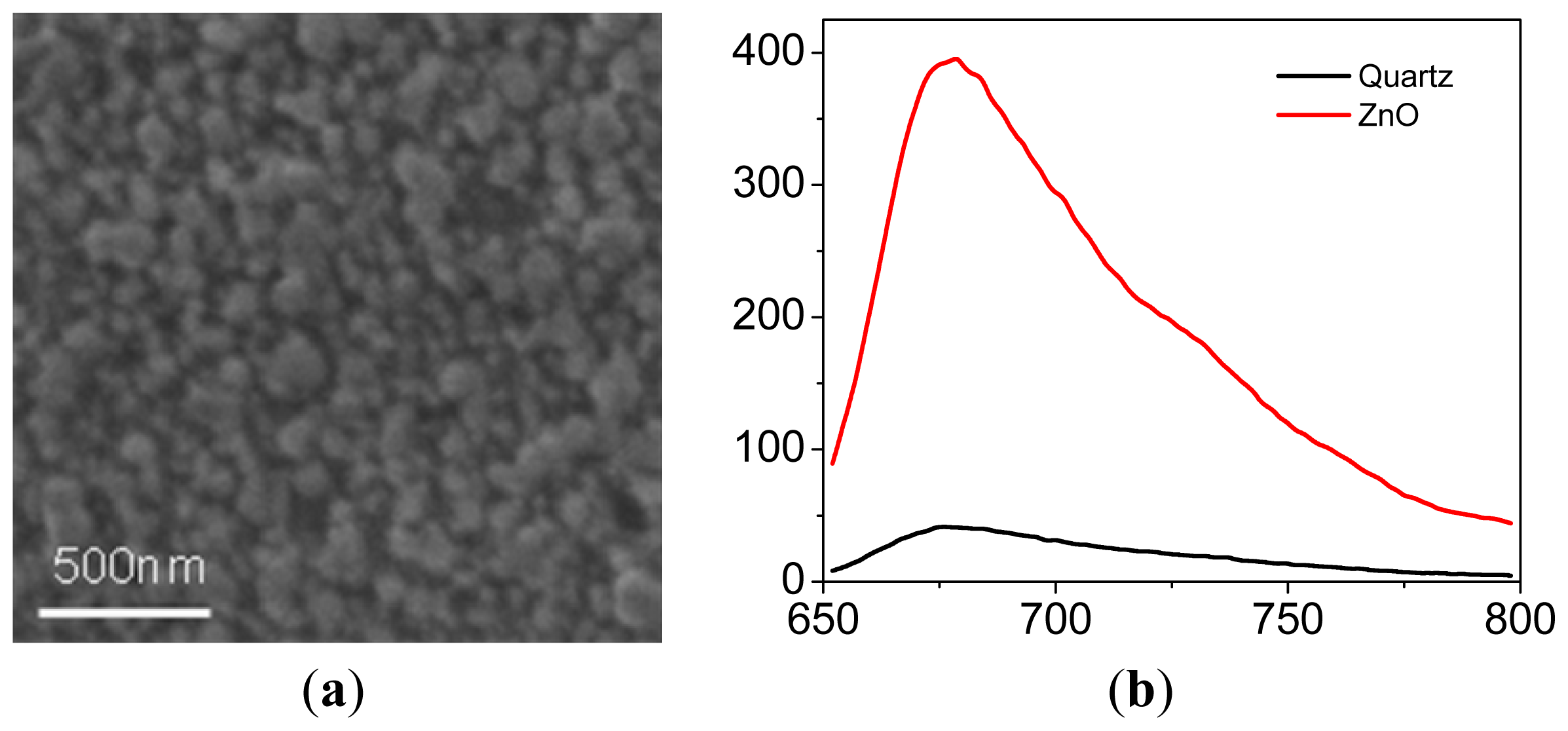
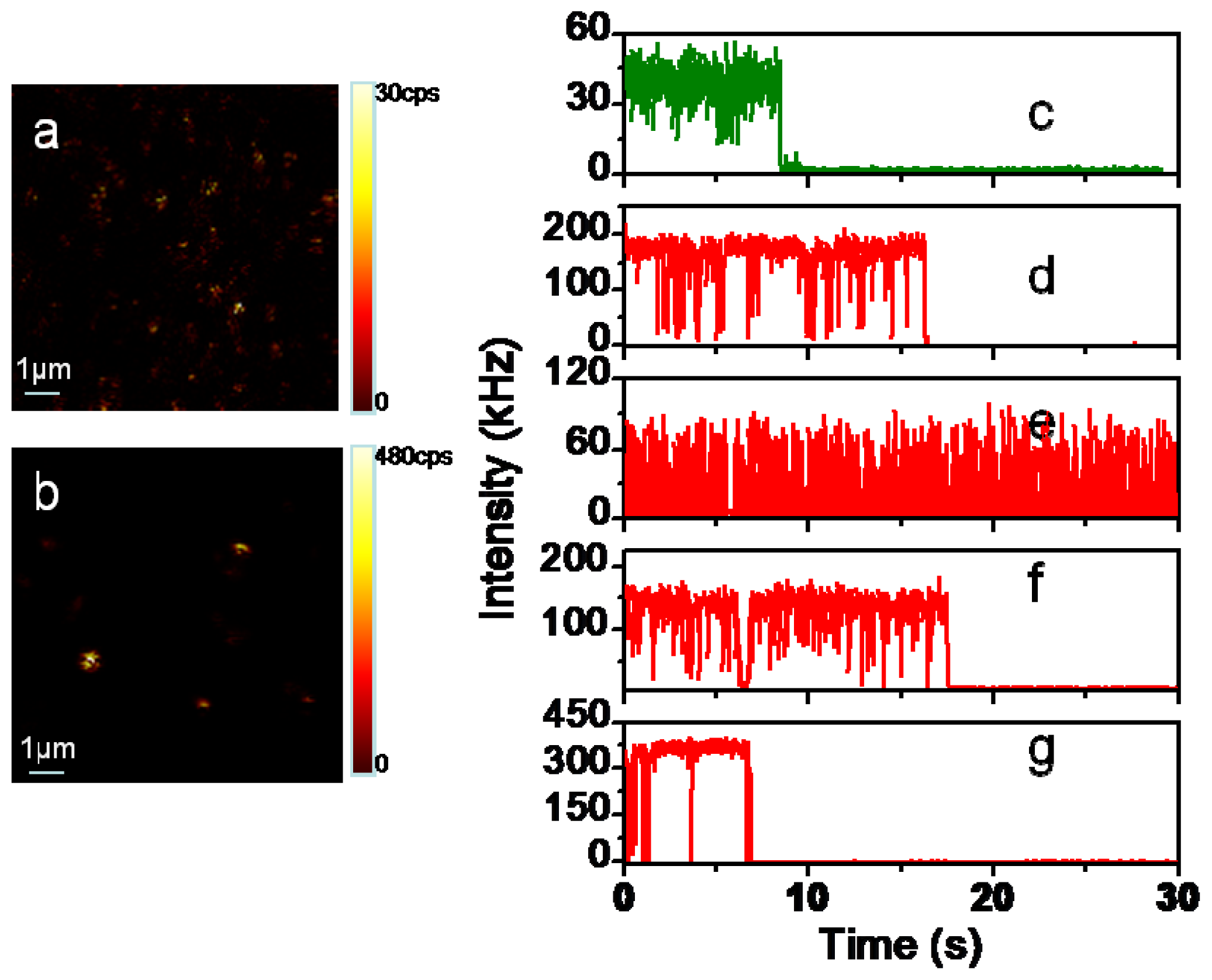
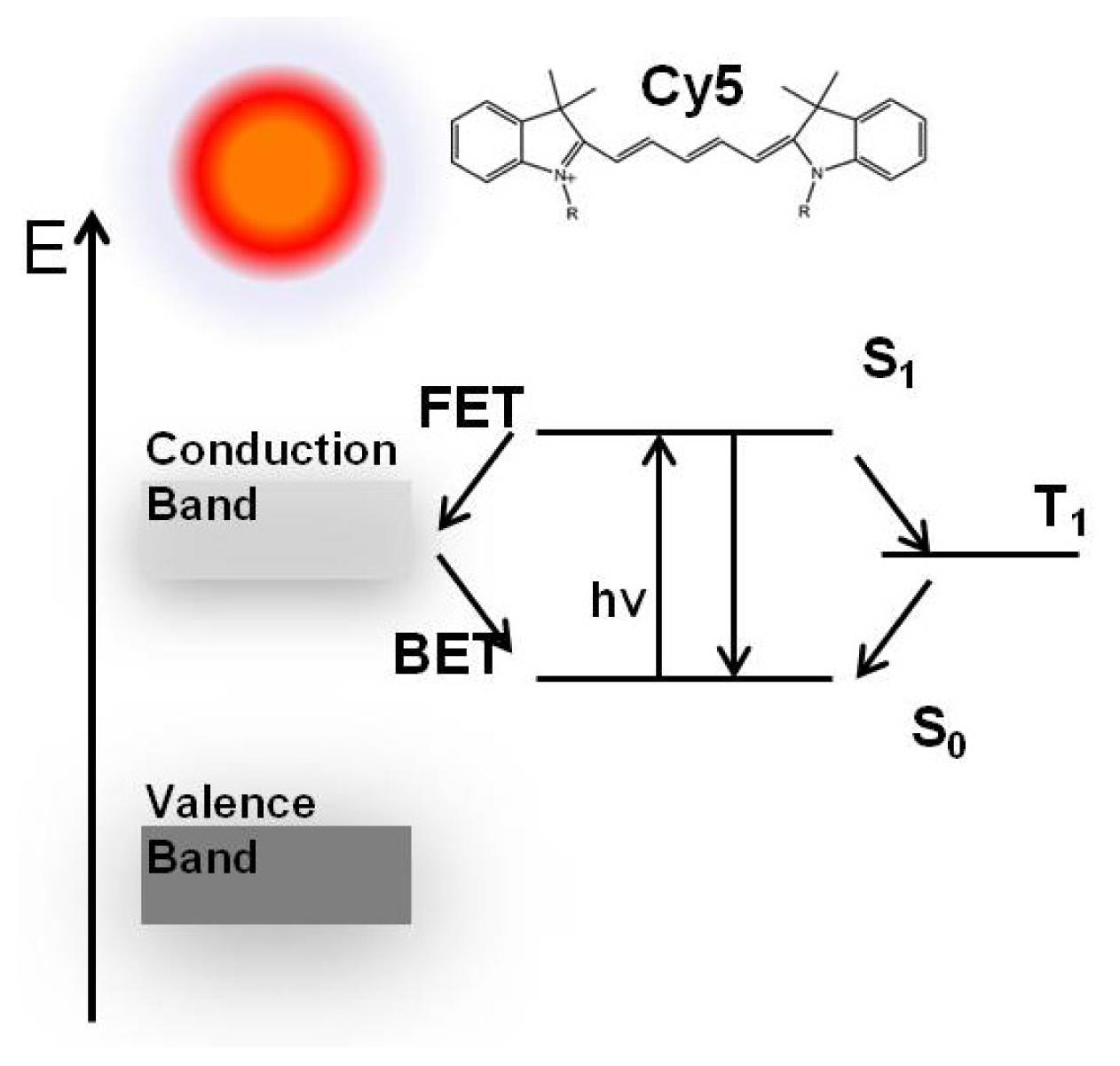
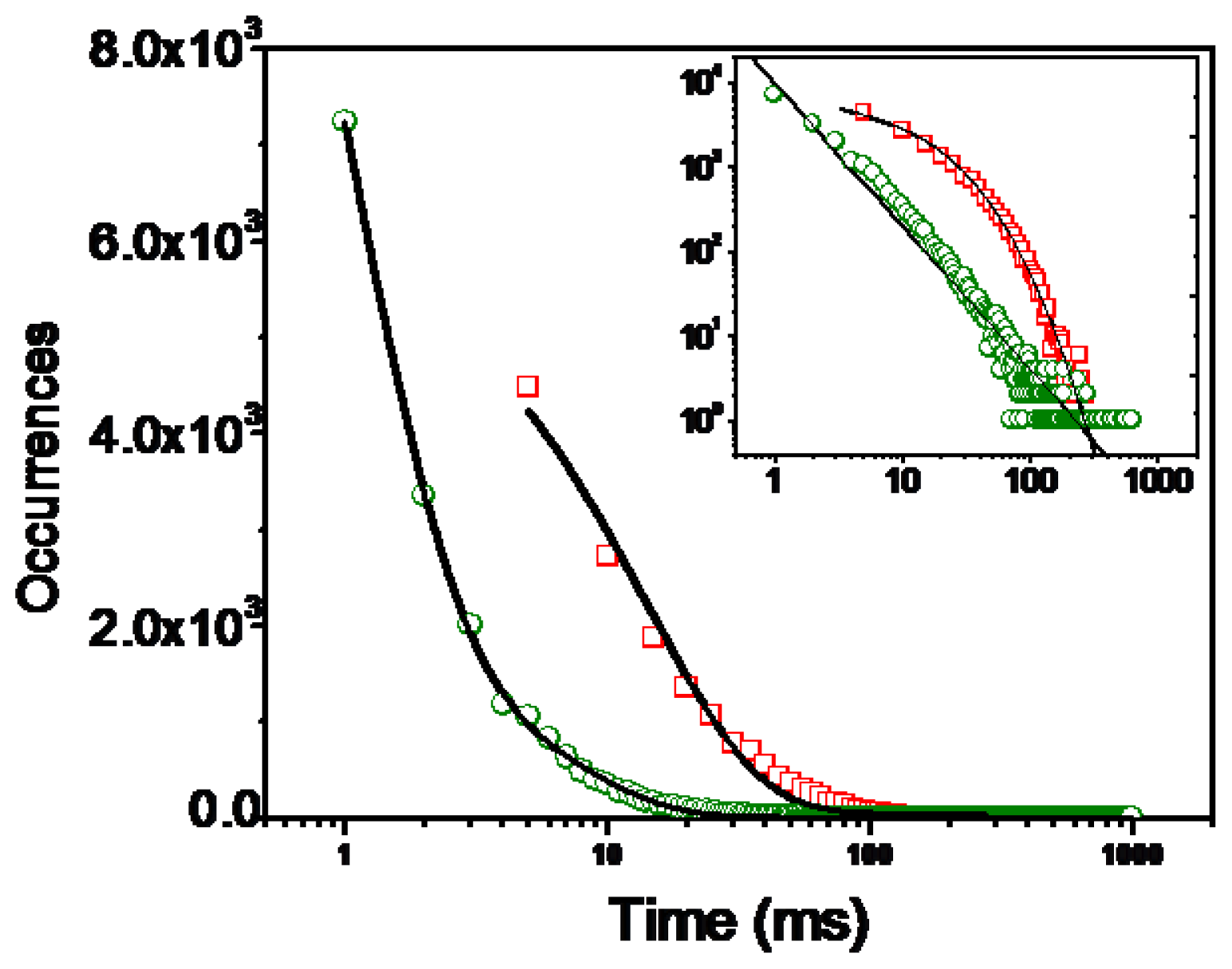
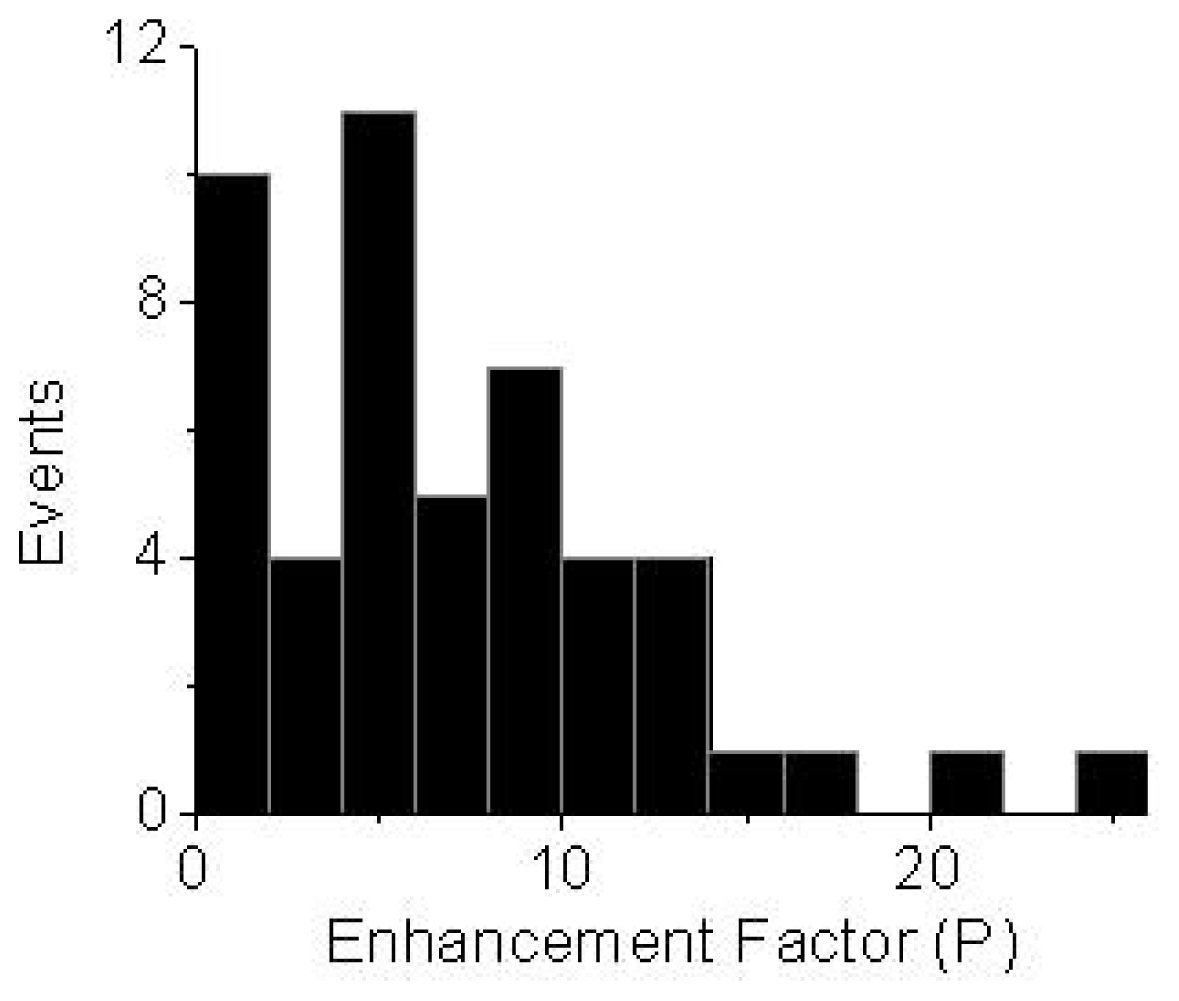
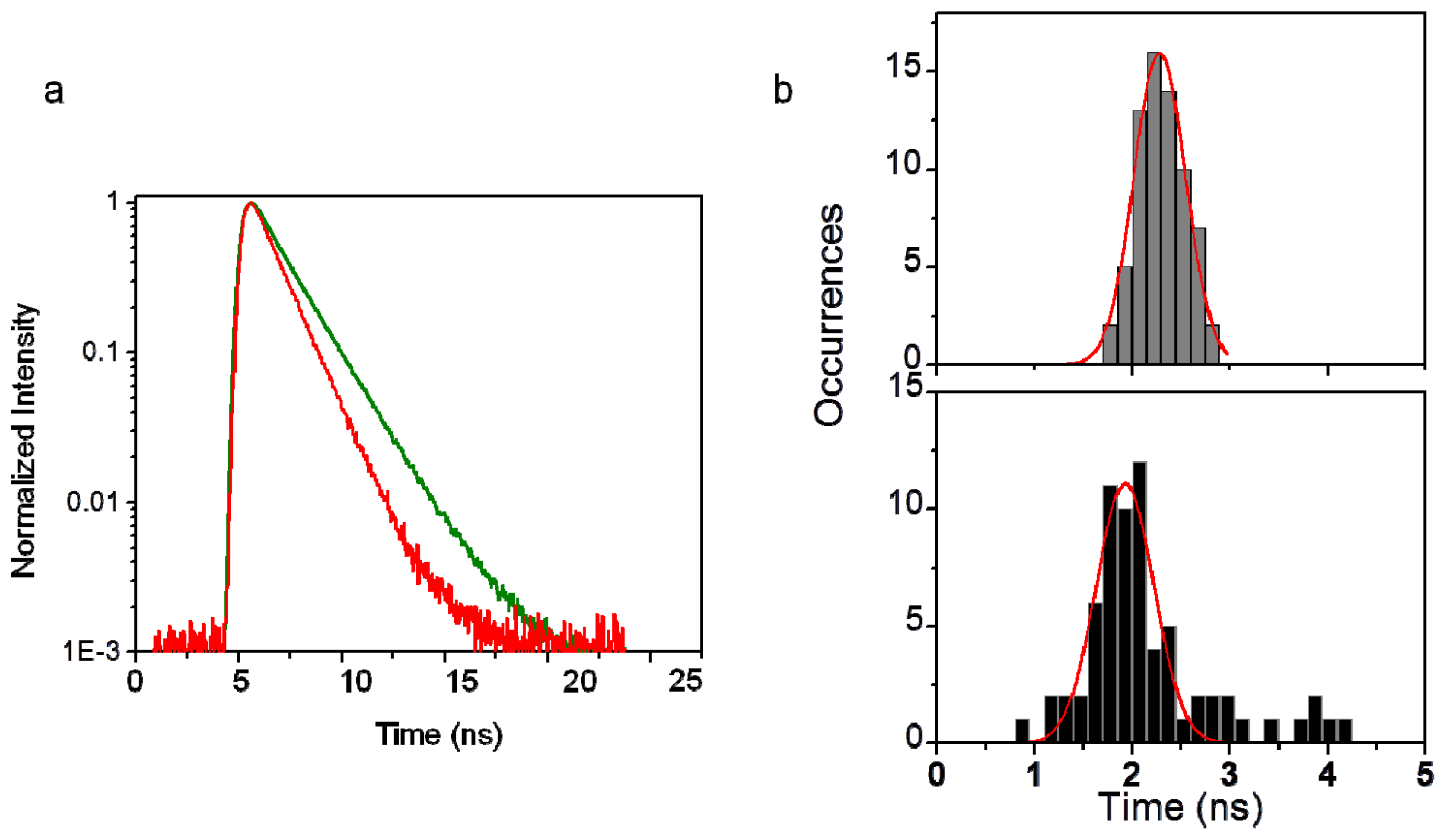
| Trace | α1 | τ1 (ns) | α2 | τ1(ns) | τavg(ns) |
|---|---|---|---|---|---|
| d | 0.086 | 1.38 | 0.914 | 2.49 | 2.4 |
| e | 0.888 | 1.34 | 0.112 | 1.49 | 1.35 |
| f | 0.076 | 1.12 | 0.924 | 1.92 | 1.86 |
| g | 0.753 | 1.11 | 0.247 | 2.82 | 1.53 |
© 2012 by the authors; licensee Molecular Diversity Preservation International, Basel, Switzerland. This article is an open-access article distributed under the terms and conditions of the Creative Commons Attribution license (http://creativecommons.org/licenses/by/3.0/).
Share and Cite
Fu, Y.; Zhang, J.; Lakowicz, J.R. Photophysical Behaviors of Single Fluorophores Localized on Zinc Oxide Nanostructures. Int. J. Mol. Sci. 2012, 13, 12100-12112. https://doi.org/10.3390/ijms130912100
Fu Y, Zhang J, Lakowicz JR. Photophysical Behaviors of Single Fluorophores Localized on Zinc Oxide Nanostructures. International Journal of Molecular Sciences. 2012; 13(9):12100-12112. https://doi.org/10.3390/ijms130912100
Chicago/Turabian StyleFu, Yi, Jian Zhang, and Joseph R. Lakowicz. 2012. "Photophysical Behaviors of Single Fluorophores Localized on Zinc Oxide Nanostructures" International Journal of Molecular Sciences 13, no. 9: 12100-12112. https://doi.org/10.3390/ijms130912100




